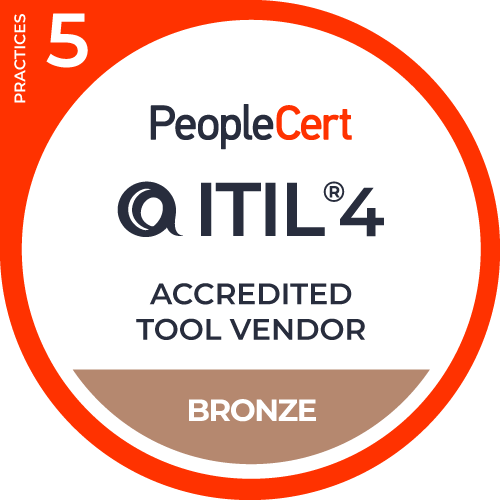I suspect that most of my readers have heard of ITIL, the world’s most popular set of practices for IT service management. In fact, I’d guess that many of you have probably already tried to “implement” ITIL. Sadly, however, many of those who do try find that it isn’t as easy as they’d expected. If that’s the case, this blog is for you; I’m hoping to show you just how easy it can be to get started with ITIL, and how quickly it can lead to tangible benefits for you, for your colleagues, and for your customers.
If you’ve read other articles about how to get started with ITIL then you probably think you already know what you’ll be getting. You’ll be expecting me to write about how implementing processes and tools for incident management, problem management, change enablement etc. can transform your IT department. But I’m not going to do that. The thing is that, regardless of what you might have read previously, at its heart, ITIL isn’t about implementing processes and tools, important as these things may be. No, the most important thing ITIL has to teach us is that IT service management is about creating value for our customers.
And the first step to doing that is identifying who our customers are.
Who Are Your Customers?
This sounds like such an obvious question, that I’m constantly amazed by how many people working in IT can’t give a clear answer. If you think about relationships in a typical IT department then you may have an image like this…

Teams with names like “Storage team” or “Windows team” create the infrastructure. These infrastructure teams have customers in application teams. Application teams have customers in business units with names like “Manufacturing” or “Sales”, and these business units, in turn, create value for external (paying) customers. (I refer to paying customers here, but some services are delivered for the public good, rather than for a paying customer). If everybody in IT understands how they fit into a value stream like this one, and how they contribute to the creation of value for paying customers, then you’ve made a very good start. If, however, the people in the storage team just think about what they must do to deliver storage, and the application team just think about what they have agreed to deliver to the business units, then things start to become much more problematic. It’s all too easy to end up with a dysfunctional approach where staff deliver what they’ve been told to, but customers are left unhappy with the outcomes.
Outcomes, Value, Costs, and Risk
Did you notice how I slipped the word “outcomes” into the end of that paragraph? This is a very important term in ITIL. Outcomes are the things that IT services help our customers to achieve. It’s these outcomes that create value for customers. For example, a finance company could have a “mortgage support” IT service, that helps them to process mortgage applications. The outcome for customers is a loan, and this creates value because it enables them to buy a house or apartment.
Every IT service must create value by helping customers to achieve outcomes that they desire, and if you understand the outcome, and how this creates value for the customer, then this will enable you to plan and design everything you do in a way that contributes to value for the customers.
But ITIL also says that you should think about the costs and risks involved in every service, and that these also contribute to the value. The costs include not only the cost of creating and running the service, but also any costs to the customers of using the service. For our mortgage support service this might include training for the mortgage agents, network links to branch offices, provision of laptops or tablets, desk space and power connections and many other costs. Risks that should be considered might include times when the service is not working, or the network is down, or the agent’s tablet is faulty. There’s also the risk involved in granting a mortgage to someone who is not able to repay the loan, as well as the risk of transferring money to the wrong bank account. All these risks, and many more, must be managed if the service is to create value for the customers.
And it takes a lot of work to continually improve how well we manage such risks.
Continual Improvement
Continual improvement is another critically important ITIL term that you need to understand. As a manager, it’s easy to believe that the best way to introduce ITIL is to find a book that tells you how to manage IT services, read it carefully, and then follow the instructions. This approach won’t work. However clever you are, however meticulously you try to do it by the book, you will very rapidly find yourself drowning in detail, and what’s worse, facing considerable resistance because the practices in the book have not been adapted to work in your specific environment.
Instead, you need to start with something very simple, and then use monitoring and feedback to create improvement. This way you can deliver some value really quickly, and as you improve, you create more and more value over time. In ITIL v3/2011 there was an entire ITIL book about continual improvement, and now it's a key part of the Service Value System and one of the 34 management practices in ITIL 4, but the basics are very simple and they can applied at all levels. You can continually improve an IT service, or the skills of a team, or the process you use to manage incidents or anything else you do. Here’s how:
- Make sure everyone understands what you’re trying to achieve. This is usually in the form of a vision, a clearly-communicated idea of what success looks like
- Measure how well you’re doing, but remember that your measurement is NOT your goal, it’s just a tool you use to indicate trends and thresholds
- Get feedback at every point in your value chain. This means talking to the people who are the direct recipients of the work you do, and understanding how you impact the overall value chain and the paying customers
- Think about how you could do things better, and devise a safe experiment to test out your ideas
- Run your experiment and see if you were right. If you were, consolidate the work, and expand on it in the future; if you were wrong then revert to the previous state and try something different
If you operate on the assumption that continual improvement is something that a continual improvement manager does, while you get on with your work, then you’ll be unable to develop. To achieve continual improvement, everybody in the organization needs to be thinking about how to work better. Sometimes this will involve small changes that don’t affect other people. At other times there may be major structural changes that require involvement from most of the company. But big changes or small ones, continual improvement should be going on all the time at multiple levels.
How to Get Started
If you’ve read this far, then you can probably already see what you need to do to get started. It’s as simple as talking to the people around you to make sure that you all understand how the work you do contributes to creating value for customers. If you manage a team then talk to them about customers, value, outcomes, costs, and risks. If everybody thinks about what they do in these terms, then the next step will be much easier.
Next you should think about feedback loops. Who can you ask for feedback on the work you’ve done, to make sure it’s what they need; and just as important, who can you offer feedback to, to help them improve the way they support you. Think about what measurements you can make to help you see trends, and predict issues before they occur.
Finally start making improvements. Start small, with simple things that you can do with low risk, and make sure that you measure the impact they have on the people around you, and on the value, outcomes, costs, and risks of the IT services. This is where you might find the detail in the ITIL publications useful. When you discover a need to improve how you manage changes, or incidents, or problems, etc. then you can look at the ITIL guidance to get ideas. Don’t just copy what’s in the book though, use it as a starting point for your own improvement planning.
This may all sound too straightforward to be effective, but that is because it really is that simple! The hardest part is changing your organizational culture to focus on making improvements that affect the value you create for customers. Actually doing the improvement work is much easier!
You can learn more about some of the ideas in this blog by reading the entry-level ITIL publication, ITIL Foundation. If you do this, you’ll also discover the seven guiding principles that can help to keep your IT service management improvements on track.











